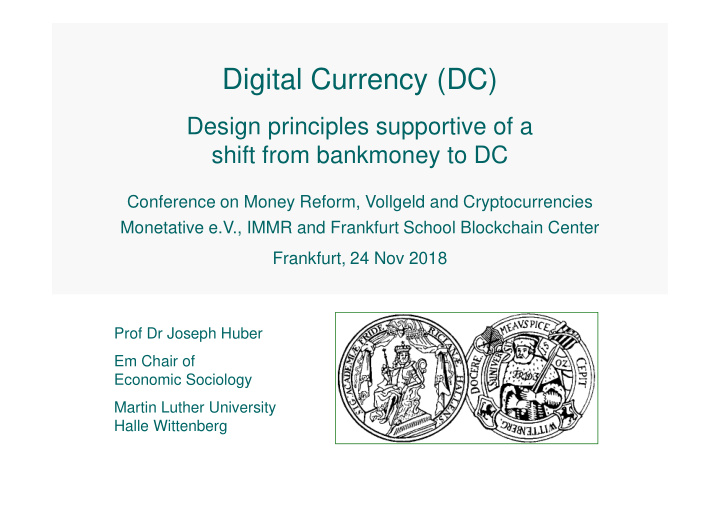



Digital Currency (DC) Design principles supportive of a shift from bankmoney to DC Conference on Money Reform, Vollgeld and Cryptocurrencies Monetative e.V., IMMR and Frankfurt School Blockchain Center Frankfurt, 24 Nov 2018 Frankfurt, 24 Nov 2018 Prof Dr Joseph Huber Em Chair of Economic Sociology Martin Luther University Halle Wittenberg
Explanation of Terms Digital Currency (DC) = central bank issued fiat money = legal tender = sovereign money like treasury coins and cbk notes and reserves = money-on-account (deposit money) rather than cryptocurrency rather than cryptocurrency DC as considered by BoE staff or the E-Krona proposed by the Swedish Riksbank both represent varieties of DC.
M1 Bankmoney (demand deposits) vs Cash Predominance of bankmoney. Marginalisation of central-bank money Switzerland 1905 – 2010 Data: Swiss National Bank, Historical Time Series, No.1, Feb 2007, 1.3, 2.3
Rise of the bankmoney regime, marginalisation of central-bank money 100% 90% Central-bank money (cash) 80% 70% 60% 50% Bankmoney (sight deposits) Bankmoney (sight deposits) 40% 30% 20% M1 Germany 1948 – 2017 10% cash vs 90% bankmoney 10% 0% 1948 1950 1955 1960 1965 1970 1975 1980 1985 1990 1995 2000 2005 2010 2013 2016 2017 Sichtdepositen Bargeld Daten: Deutsche Bundesbank, Monatsberichte , Tabellen zur bankstatistischen Gesamtrechnung, 1954-2017.
Advantages of Digital Currency � Enhanced transmission and thus improved effectiveness of conventional instruments of monetary policy � Complete safety. No counterparty risk in bank payments. DC thus highly trusted and accepted � � Comfort and costs of handling equal to bankmoney Comfort and costs of handling equal to bankmoney � Costs of financing for banks about the same as with cash. Costs of handling much lower. � Increased seigniorage (gain from money creation) to the benefit of the public purse.
Assumed problems with DC side-by-side with bankmoney � Impaired ability of banks to lend and invest? � Pro-cyclical shifting of account balances between bankmoney and DC? � Heightened risk of bankruns? � Deposit interest as well as negative interest on DC? � Deposit interest as well as negative interest on DC? � New Gresham situation? (threatened 1:1 parity of bankmoney with DC).
Design principles supportive of a shift towards DC � No restrictions on access to and quantities of DC � Merging DC and interbank reserves into one circuit � Full convertibility between bankmoney and DC … � … including a conversion guarantee by the central bank, particularly in a bankrun situation � � Gradually reducing and ultimately removing state Gradually reducing and ultimately removing state warranties of bankmoney � Public bodies gradually increasing the use of DC � Credit to banks not the only channel of issuance of DC � Central-bank deposit interest on DC equal to deposit interest on bankmoney � Ruling out negative interest.
Concluding Remark The modern world has been living for 150–300 years with the conflicting situation of sovereign money and bankmoney coexisting side-by-side. DC side-by-side with bankmoney will basically not be too different from that. At all events, it is a step forward, coming to a degree At all events, it is a step forward, coming to a degree with the advantages mentioned above. By comparison, the problems inherent to the present near-complete rule of bank-money are still much bigger than problems related to DC ever might be.
Digital Currency (DC) Design principles supportive of a shift from bankmoney to DC Conference The Future of Money Monetative e.V., IMMR and Frankfurt School Blockchain Center Frankfurt, 24 Nov 2018 Frankfurt, 24 Nov 2018 Prof Dr Joseph Huber Em Chair of Economic Sociology Martin Luther University Halle Wittenberg
Recommend
More recommend